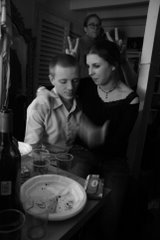
We had an amazing time and one of my highlights was visiting the new Egyptian gallery in the BM. I've always loved their Egyptian wing and when I was a child would spend ages with my poor suffering mother looking at the Rosetta stone and animal mummies, the dried out corpse of Ginger and other slightly gruesome displays. Later I also started to appreciate the statues and artefacts, pottery, jewellry and so on, and know a bit more about Ancient Egyptian history and archeology.
This new gallery is like nothing I have ever seen before. It is a actually an average sized room that is solely dedicated to the tomb of an temple accountant who lived three and a half thousand years ago. The famous Egyptian tombs are typically royal ones : from the valley of the Kings to Tutankhamon's, or the even more ancient pyramids. The lives and deaths of the everyday Egyptians are comparatively unknown. A few years ago the Louvre had an exhibition on the people who made the pyramids, not slaves as it turns out(contrary to popular belief) but highly skilled craftsmen, experts in stone cutting, woodwork, engraving, painting and so on. It looked in to the lives of the Egyptian working classes, neither pharoahs nor farmers nor slaves.
In a similar way, this tomb is the tomb chapel of Nebamun, a "scribe and counter of grain" who died in around 1400 BC. His tomb chapel was discovered in the 1820s by a Greek grave robber who later sold the incredible paintings that are on display. Though we know the tomb was located near the city/temple devoted to Amun, where he worked, in Thebes (today Luxor),the exact location is today lost. Though it is a tomb, the paintings are a celebration of Nebamun's life, with paintings glorifying his everyday activities, from fishing to family and his job. The eleven large fragments, which have been restored and preserved over the last decade, are beautiful in colour and the level of detail in each one is captivating; the artist is unknown but has been called an "ancient Egyptian Michaelangelo".
One painting shows a young Nebamun fishing on the marshes and surrounded by spieces of birds and reeds and fat fish. Amongst the reeds his cat is somersaulting and hunting. The different species symbolise life, rebirth and vitality which is what the painting inspires.

In another, we see Nebamun at work. His name literally means "he works in the service of Amun", to whom the temple which employed him was dedicated. Here he is counting and inspecting cattle, who have been painted in such a way that you can hear the clatter of their hooves and the shouts of the servants driving them.

In another, slave giirls entertain at a banquet: a display of luxury, sensuality and wealth.

The exhibition also has a terrific 3D video that explains the tomb chapel's probable location and layout, and has some nice artefacts such as toys, jewelry, games and preserved offerings. The explanations are great and fascinating (such as the fact that the word "Amun", present everywhere in the hieroglyphs, including in Nebamun's name, was smashed centuries later) and to top it all the whole gallery, like the rest of the museum, is free.



Aucun commentaire:
Enregistrer un commentaire